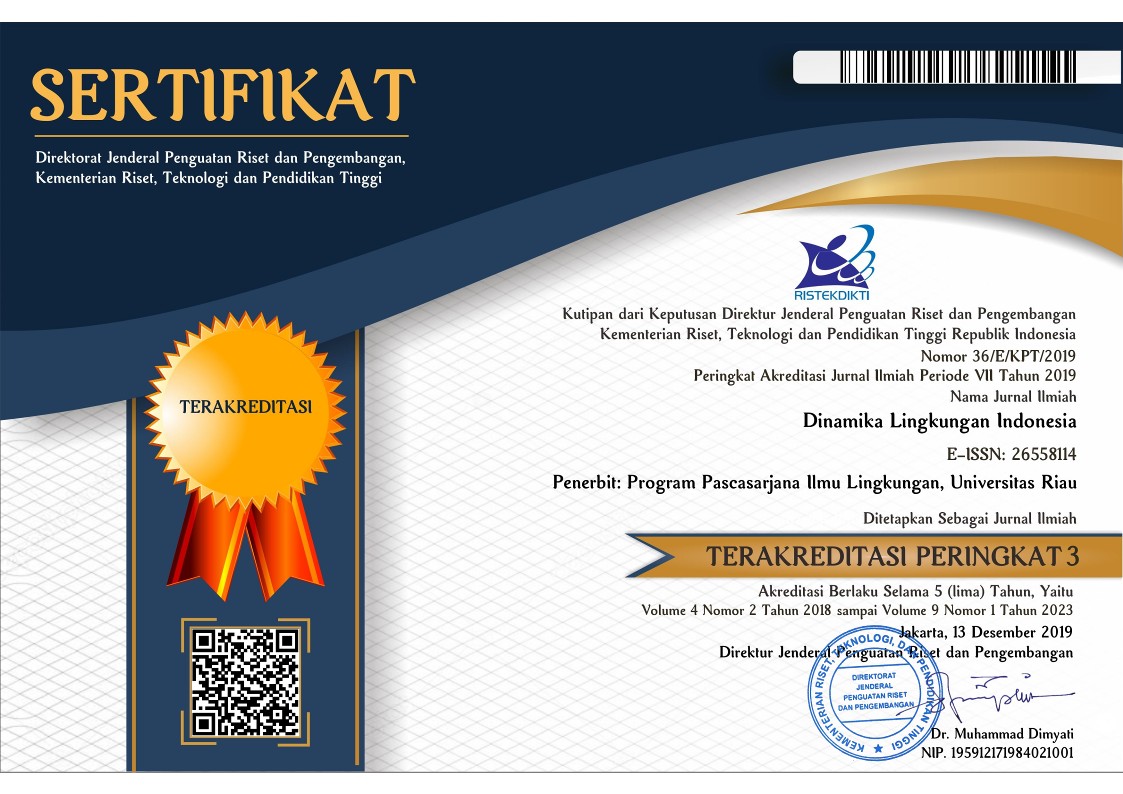Analisis Pengolahan Sampah Restoran di Kota Jambi
Abstract
Keywords
Full Text:
PDFReferences
Ananno, A. A., Masud, M. H., Chowdhury, S. A., Dabnichki, P., Ahmed, N., & Arefin, A. M. E. (2021). Sustainable food waste management model for Bangladesh. Sustainable Production and Consumption, 27, 35–51. https://doi.org/10.1016/j.spc.2020.10.022.
BPS Kota Jambi. (2020). Kota Jambi Dalam Angka 2020. https://jambikota.bps.go.id/.
BPS Kota Jambi. (2023). Kota Jambi Dalam Angka 2023.
BPS Provinsi Jambi. (2022). Provinsi Jambi Dalam Angka 2022. https://jambi.bps.go.id/.
BSN. (1994). Metode pengambilan dan pengukuran contoh timbulan dan komposisi sampah perkotaan (SNI 19-3964-1994). Badan Standarisasi Nasional.
De Clercq, D., Wen, Z., & Fan, F. (2017). Performance evaluation of restaurant food waste and biowaste to biogas pilot projects in China and implications for national policy. Journal of Environmental Management, 189, 115–124. https://doi.org/10.1016/j.jenvman.2016.12.030.
Dortmans, B., Diener, S., Verstappen, B., & Zurbrügg, C. (2017). Black Soldier Fly Biowaste Processing : A Step-by-Step Guide. Eawag – Swiss Federal Institute of Aquatic Science and Technology.
Feodorov, C., Velcea, A. M., Ungureanu, F., Apostol, T., Robescu, L. D., & Cocarta, D. M. (2022). Toward a Circular Bioeconomy within Food Waste Valorization: A Case Study of an On-Site Composting System of Restaurant Organic Waste. Sustainability (Switzerland), 14(14), 1–10. https://doi.org/10.3390/su14148232.
Filimonau, V., Nghiem, V. N., & Wang, L. en. (2021). Food waste management in ethnic food restaurants. International Journal of Hospitality Management, 92(September 2020), 102731. https://doi.org/10.1016/j.ijhm.2020.102731.
Giaccherini, M., Gilli, M., Mancinelli, S., & Zoli, M. (2021). Nudging food waste decisions at restaurants. European Economic Review, 135, 103722. https://doi.org/10.1016/j.euroecorev.2021.103722.
Gruia, R., Florescu, G. I., Gaceu, L., Oprea, O. B., & Ţane, N. (2021). Reducing environmental risk by applying a polyvalent model of waste management in the restaurant industry. Sustainability (Switzerland), 13(11), 1–14. https://doi.org/10.3390/su13115852.
Hamid, K. B. A., Ishak, M. Y., & Samah, M. A. A. (2015). Analysis of municipal solid waste generation and composition at administrative building café in Universiti Putra Malaysia: A case study. Polish Journal of Environmental Studies, 24(5), 1969–1982. https://doi.org/10.15244/pjoes/39106.
Hidayat, S. I., Ardhany, Y. H., & Nurhadi, E. (2020). Kajian food waste untuk mendukung ketahanan pangan. Journal of Agriekonomika, 9(2), 171–182. https://doi.org/https://doi.org/10.21107/agriekonomika.v9i2.8787.
Hoornweg, D., & Bhada-Tata, P. (2012). What A WASTE: A Global Review of Solid Waste Management. World Bank.
Kim, C. H., Ryu, J., Lee, J., Ko, K., Lee, J. Y., Park, K. Y., & Chung, H. (2021). Use of black soldier fly larvae for food waste treatment and energy production in asian countries: A review. Processes, 9(1), 1–17. https://doi.org/10.3390/pr9010161.
Lemy, D. M., Rahardja, A., & Kilya, C. S. (2020). Generation Z Awareness on Food Waste Issues (A Study In Tangerang, Indonesia). Journal of Business on Hospitality and Tourism, 06(02), 329–337.
Malina, A. C., Suhasman, Muchtar, A., & Sulfahri. (2017). Environmental Assessment of Waste Sorting Sites in Makassar City. Journal of Innovation and Public Service, 1(1), 14–27.
Pasymi, Sundari, E., & Munzir, A. (2022). Pengolahan sampah organik menggunakan larva black soldier fly atau maggot. Jurnal IRIS : Implementasi Riset, 2(1), 44–54. https://iris.lppm.bunghatta.ac.id/.
Permenparekraf. (2021). Peraturan Menteri Pariwisata dan Ekonomi Kreatif Nomor 4 Tahun 2021 tentang Standar Kegiatan Usaha Pada Penyelenggaraan Perizinan Berusaha Berbasis Risiko Sektor Pariwisata.
Rukmini, P., Rozak, D. L., & Winarso, S. (2020). Pengolahan Sampah Organik Untuk Budidaya Maggot Black Soldier Fly (BSF). Seminar Nasional Pengabdian Kepada Masyarakat UNDIP 2020, 3, 250–253. semnasppm.undip.ac.id II.
SIPSN. (2022). Timbulan Sampah Kota Jambi 2021. https://sipsn.menlhk.go.id/sipsn/public/data/timbulan.
SIPSN. (2023). Timbulan Sampah Nasional. https://sipsn.menlhk.go.id/sipsn/.
Syaukat, Y., Falatehan, A. F., Nasrullah, N., Hastuti, H., Raswatie, F. D., Amanda, D., & Hardjanto, A. (2021). The economic value of restaurant food waste in Bogor. KnE Social Sciences, 2021, 741–750. https://doi.org/10.18502/kss.v5i5.8856.
Taiwo, A. M. (2011). Composting as a sustainable waste management technique in developing countries. Journal of Environmental Science and Technology, 4(2), 93–102.
Vinck, K., Scheelen, L., & Du Bois, E. (2019). Design opportunities for organic waste recycling in urban restaurants. Waste Management and Research, 37(1_suppl), 40–50. https://doi.org/10.1177/0734242X18817714.
DOI: http://dx.doi.org/10.31258/dli.11.1.p.55-60
Refbacks
- There are currently no refbacks.

This work is licensed under a Creative Commons Attribution 4.0 International License.





